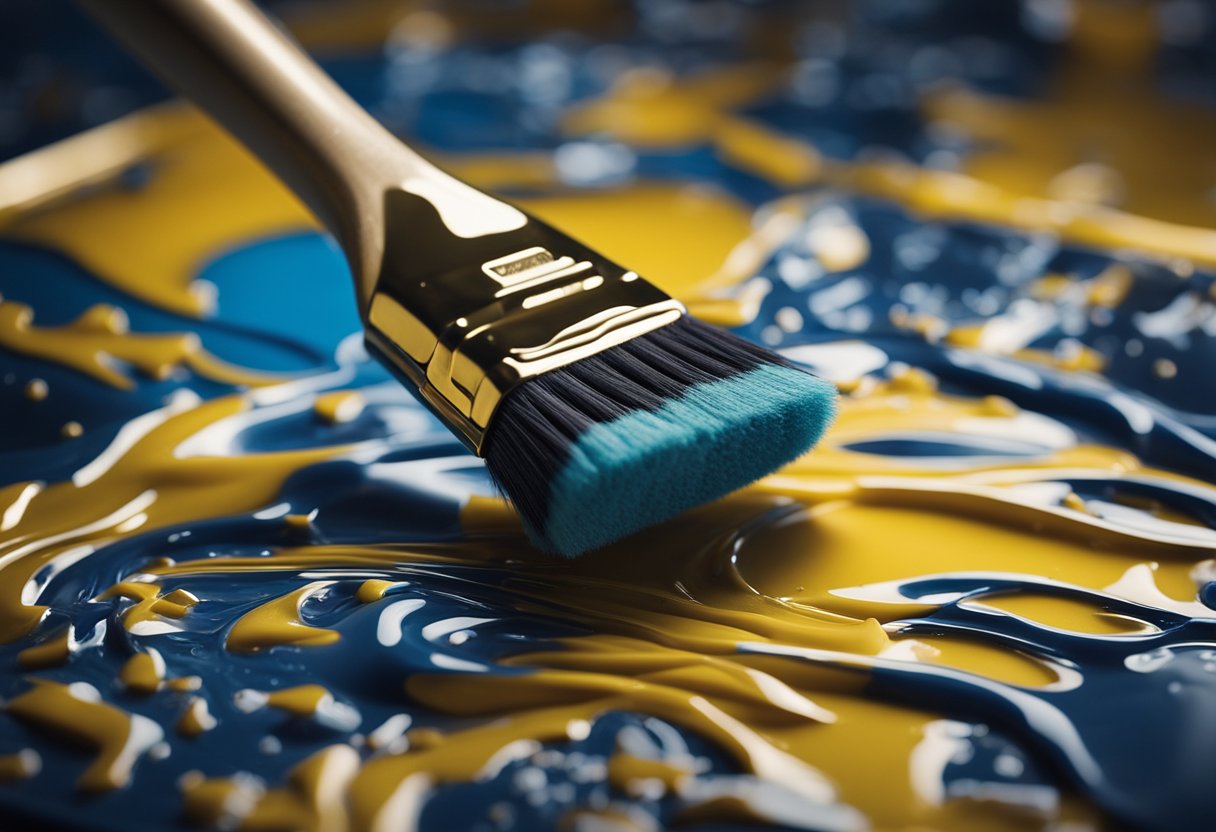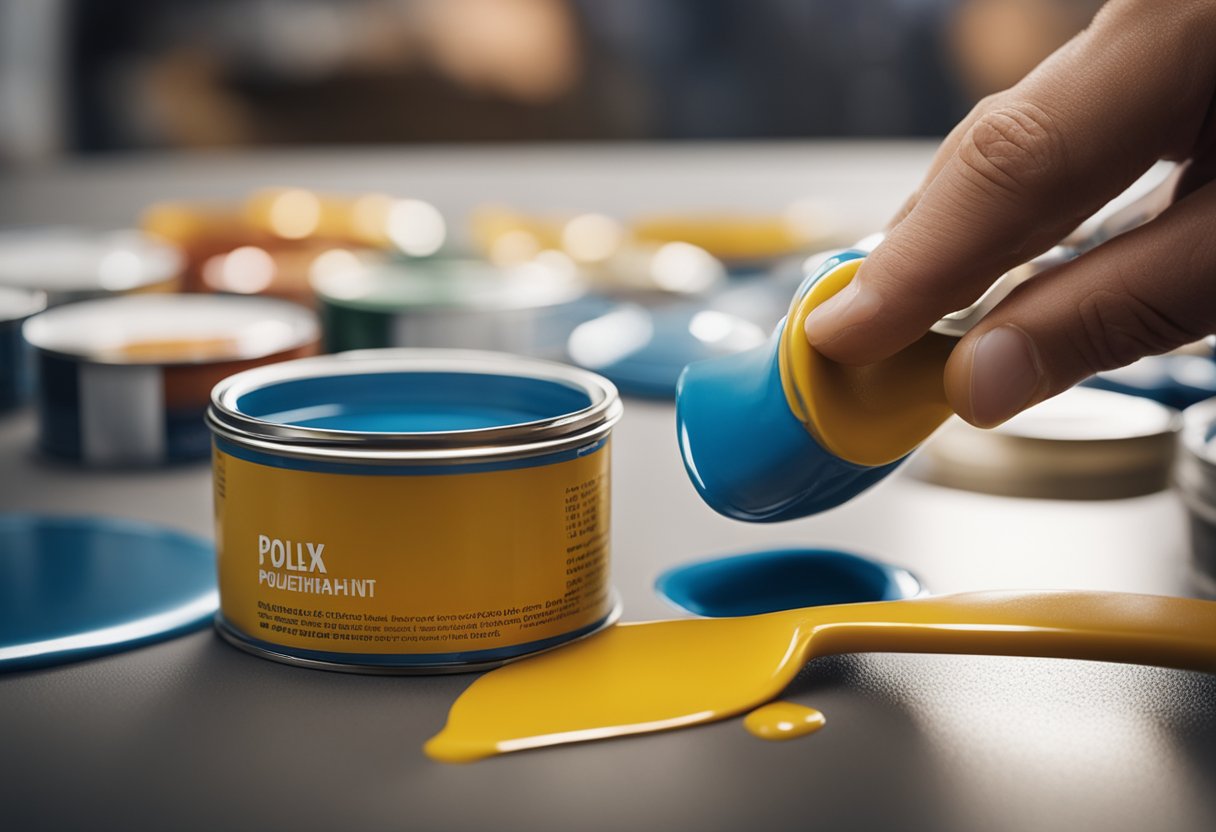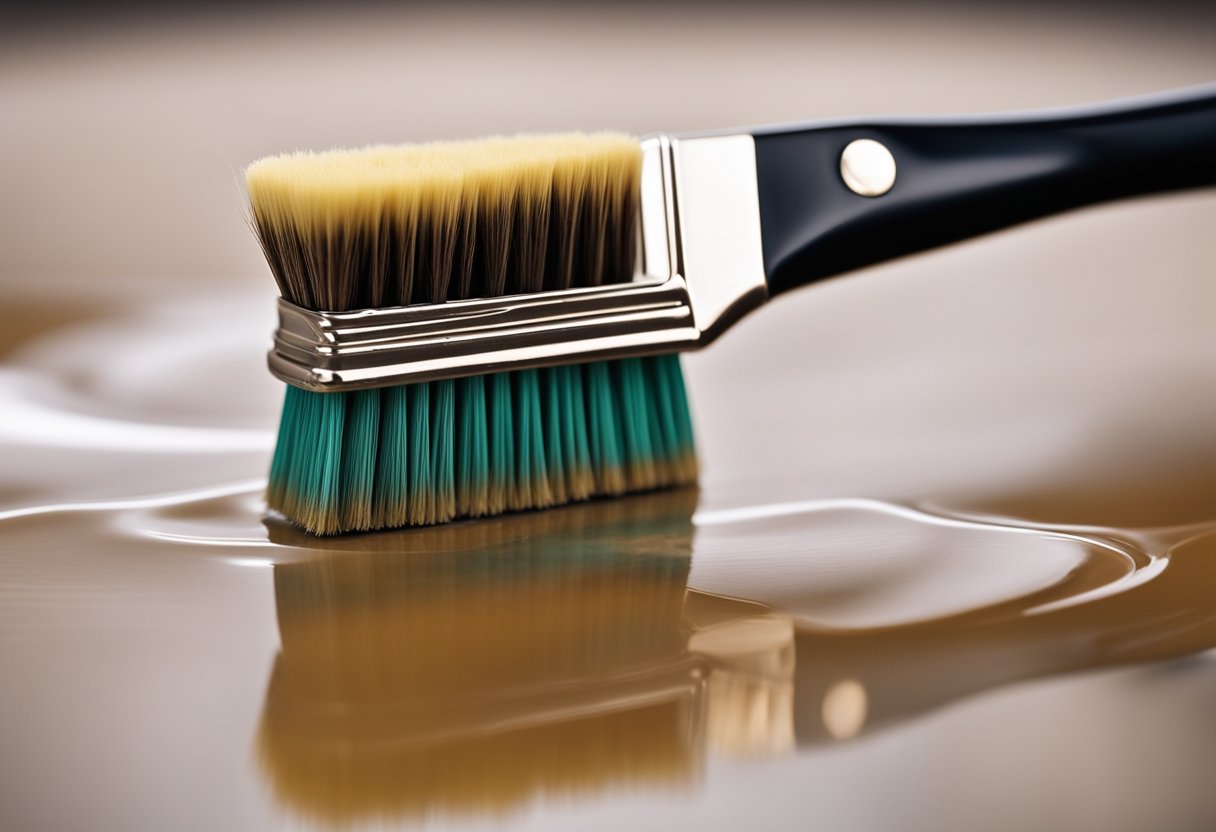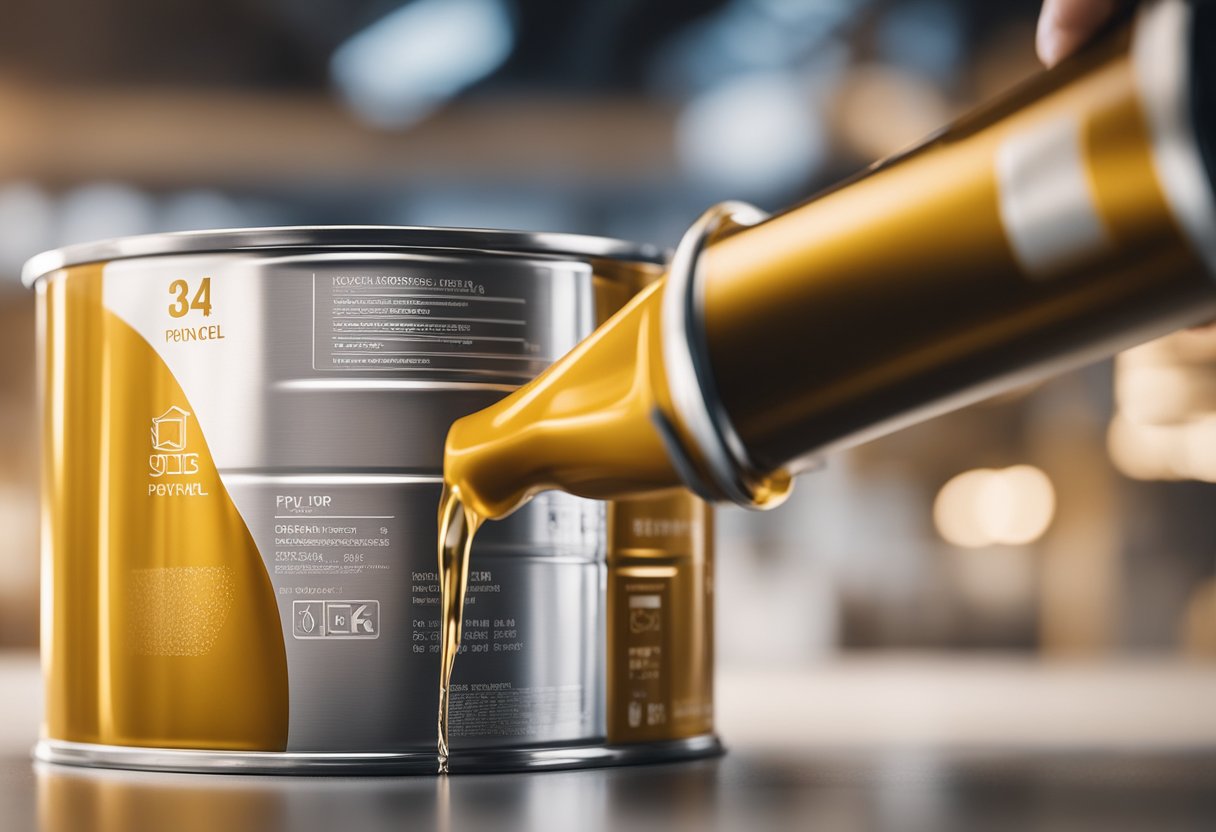Polyurethane is a popular choice for protecting and adding shine to painted surfaces. Enamel paint is also a durable and glossy paint that is commonly used on surfaces such as furniture, cabinets, and trim. It is natural to wonder if polyurethane can be applied over enamel paint to improve its durability and appearance.
The answer is yes, but there are important considerations to keep in mind before applying polyurethane over enamel paint. Understanding the properties of both paints and following proper preparation and application techniques are crucial for achieving a successful finish. In this article, I will discuss the key factors to consider when applying polyurethane over enamel paint, including the type of polyurethane to use, preparation steps, and application techniques.
Key Takeaways
- Polyurethane can be applied over enamel paint, but proper preparation and application techniques are crucial for achieving a successful finish.
- Water-based, oil-based, and exterior-based polyurethane can be used over enamel paint, but oil-based polyurethane is more compatible.
- Surface preparation, including cleaning and sanding, is essential for ensuring proper adhesion between the two coatings.
Understanding Polyurethane and Enamel Paint
https://www.youtube.com/watch?v=Ps4dkMaAzQ8&embed=true
As someone who has worked with various types of paints, I have found that polyurethane and enamel paint are two of the most popular options for finishing surfaces.
Enamel paint is a type of oil-based paint that has been used for centuries. It is known for its glossy finish and durability, making it a popular choice for furniture, cabinetry, and other surfaces that experience frequent use. Enamel paint is available in a wide range of colors and can be mixed with pigments to create custom shades.
Polyurethane, on the other hand, is a clear, water-based product that is used as a protective coating. It is often used as a sealant over surfaces that have been painted with enamel paint, as it provides an extra layer of protection against moisture, scratches, and other types of damage. Polyurethane can also be used on its own to protect surfaces that have been painted with latex, acrylic, or chalk paint.
When it comes to choosing between polyurethane and enamel paint, there are a few factors to consider. The first is the appearance you are looking for. Enamel paint provides a high-gloss finish that is perfect for creating a sleek, modern look. Polyurethane, on the other hand, provides a clear, matte finish that is ideal for protecting surfaces without altering their appearance.
Another factor to consider is durability. Enamel paint is known for its durability and is often used on surfaces that experience a lot of wear and tear. Polyurethane is also durable, but it is more commonly used as a protective coating rather than a paint.
Finally, it is important to consider the type of paint you are using. Enamel paint is oil-based, while polyurethane is water-based. This means that if you are using enamel paint, you will need to use a polyurethane that is also oil-based. If you are using latex or acrylic paint, you can use a water-based polyurethane.
Overall, both polyurethane and enamel paint have their own unique benefits and can be used in a variety of ways. By understanding the differences between these two products, you can choose the one that is best suited for your project.
Preparation for Application
https://www.youtube.com/watch?v=OQCwt8kU4Ks&embed=true
Before applying polyurethane over enamel paint, proper preparation is crucial for a successful finish. Here are the steps I follow to prepare the surface:
-
Clean the Surface: I start by cleaning the painted surface thoroughly. This includes removing any dirt, dust, or debris that may have accumulated on the surface. I use a vacuum cleaner to remove any loose particles and then wipe the surface down with a damp cloth.
-
Wash the Surface: If the surface is particularly dirty or greasy, I wash it with a detergent solution. I mix a ½ cup of trisodium phosphate with warm water and use a soft sponge or rag to clean the surface. After washing, I rinse the surface with clean water and let it dry completely.
-
Sand the Surface: Next, I sand the surface to create a rough texture that helps the polyurethane adhere to the enamel paint. I use 180-grit sandpaper to scuff the surface lightly. After sanding, I wipe the surface with a damp cloth to remove any dust.
-
Stir the Polyurethane: I always stir the polyurethane thoroughly before applying it. This ensures that the product is well mixed and that the finish is consistent.
By following these steps, I ensure that the surface is clean, scuffed, and ready for polyurethane application. Proper preparation is essential for a durable and long-lasting finish.
Application Techniques
https://www.youtube.com/watch?v=dCYMxs45g6o&embed=true
When it comes to applying polyurethane over enamel paint, there are several techniques you can use. The choice of technique depends on the size of the surface you are working on, the type of polyurethane you are using, and the finish you want to achieve.
Brush Application
Brush application is the most common and easiest technique. You can use a synthetic brush or a paintbrush to apply polyurethane. Before applying, make sure the surface is clean and dry. Then, dip the brush into the polyurethane and apply it evenly on the surface. Use long, even strokes to avoid brush marks.
Spray Application
Spray application is another technique you can use to apply polyurethane. You can use a sprayer to apply polyurethane over enamel paint. This technique is ideal for large surfaces or surfaces that are hard to reach. However, it requires more skill and experience than brush application.
Roller Application
Roller application is another technique you can use to apply polyurethane. You can use a roller to apply polyurethane over enamel paint. This technique is ideal for large surfaces or surfaces that are hard to reach. However, it requires more skill and experience than brush application.
Applicator Pads
Applicator pads are another option to apply polyurethane over enamel paint. They are ideal for small surfaces or surfaces that require a more delicate touch. Applicator pads are easy to use and produce a smooth finish.
No matter which technique you choose, make sure to follow the manufacturer’s instructions for the type of polyurethane you are using. Also, make sure to wear protective gear such as gloves and a mask when applying polyurethane.
Drying and Curing Process
https://www.youtube.com/watch?v=7uoZSWof2DM&embed=true
When applying polyurethane over enamel paint, it is important to understand the drying and curing process to ensure a successful finish. Drying time refers to the amount of time it takes for the polyurethane to become touch dry. Curing time, on the other hand, refers to the amount of time it takes for the polyurethane to fully cure and harden.
The drying and curing time for polyurethane can vary depending on the type of polyurethane used. Water-based polyurethane typically has a shorter drying and curing time compared to oil-based polyurethane. Water-based polyurethane can dry in as little as 2 hours, while oil-based polyurethane can take up to 24 hours to dry.
It is important to note that drying time and curing time are not the same. While polyurethane may be touch dry within a few hours, it can take several days or even weeks to fully cure and harden. It is recommended to wait at least 24 hours before applying a second coat of polyurethane to ensure that the first coat has fully cured.
To ensure a successful finish, it is important to follow the manufacturer’s recommended drying and curing time for the specific type of polyurethane used. Rushing the drying and curing process can result in a finish that is not fully cured, which can lead to issues such as peeling or cracking.
In summary, understanding the drying and curing process is crucial when applying polyurethane over enamel paint. It is important to use the appropriate type of polyurethane and follow the manufacturer’s recommended drying and curing time to ensure a successful finish.
Maintaining and Protecting the Finish
https://www.youtube.com/watch?v=U547mOtMouw&embed=true
Once the polyurethane coat is applied over the enamel paint, it is important to maintain and protect the finish to ensure it stays looking great for as long as possible. Here are some tips:
Protect the Surface
The polyurethane coat provides a protective layer to the surface, but it is still vulnerable to scratches, wear, and tear. To protect the surface, avoid placing heavy objects on it or dragging items across it. Use coasters under glasses and trivets under hot dishes to prevent heat damage.
Apply a Second Coat
If you want extra protection, apply a second coat of polyurethane after the first coat has dried. This will add an extra layer of resilience to the finish.
Deal with Bubbles
If bubbles appear in the polyurethane coat, don’t panic. Simply wait for the coat to dry and sand it down with fine-grit sandpaper. Then, wipe the surface with a tack cloth and apply another coat.
Clean with Mineral Spirits
To clean the surface, use a damp cloth and mild soap. Avoid using harsh chemicals or abrasive cleaners that could damage the finish. If you need to remove stubborn stains, use mineral spirits on a clean cloth.
Reapply the Protective Layer
Over time, the protective layer provided by the polyurethane coat may wear off. To keep the surface looking great, reapply the polyurethane coat every few years.
Avoid Water
Water can damage the polyurethane coat, so avoid placing objects that are likely to get wet on the surface. If water does come into contact with the surface, wipe it up immediately with a dry cloth.
By following these tips, you can maintain and protect the finish of your polyurethane-coated enamel paint surface for years to come.
Benefits and Limitations
When it comes to applying polyurethane over enamel paint, there are several benefits and limitations to consider.
Benefits
One of the main benefits of applying polyurethane over enamel paint is that it adds an extra layer of protection to the surface. This topcoat is durable and long-lasting, which means it can help prevent peeling, chipping, and fading. Additionally, polyurethane can protect against rust, UV damage, and tears, making it a great choice for outdoor projects.
Another advantage of using polyurethane over enamel paint is that it can create a smooth and glossy finish. This sheen can enhance the colors of the underlying paint and make the surface look more polished.
Limitations
While there are many benefits to using polyurethane over enamel paint, there are also some limitations to consider. One of the main drawbacks is that polyurethane can be expensive, which means it may not be the best choice for projects where cost is a concern.
Another limitation is that polyurethane can be sensitive to heat. If the surface gets too hot, the polyurethane can peel or crack, which can be unsightly. Additionally, polyurethane can be prone to yellowing over time, which can affect the appearance of the surface.
Overall, there are many benefits and limitations to consider when it comes to applying polyurethane over enamel paint. While it can provide an extra layer of protection and create a glossy finish, it can also be expensive and sensitive to heat. It’s important to weigh the pros and cons carefully before deciding whether to use polyurethane as a topcoat.
Frequently Asked Questions
As I have discussed earlier, applying polyurethane over enamel paint can provide additional protection and enhance the appearance of the surface. Here are some frequently asked questions that might help you understand the process better.
Can I put polyurethane over paint?
Yes, you can put polyurethane over paint. Applying polyurethane over a painted surface offers several benefits. Polyurethane adds a layer of protection against weathering and UV damage. Depending on your choice of polyurethane, colors can be enhanced and deepened. Your surface is more resistant to scratching, impact, and general wear.
How many coats of polyurethane should I apply over enamel paint?
The number of coats of polyurethane you should apply over enamel paint depends on the level of protection and the desired appearance. Generally, one or two coats of polyurethane are enough to provide adequate protection. However, if you want a higher level of protection, you can apply more coats. Keep in mind that applying too many coats can lead to a cloudy or milky appearance.
How long should I wait before applying polyurethane over enamel paint?
You should wait at least 24 hours before applying polyurethane over enamel paint. This will ensure that the enamel paint is completely dry and cured. If you apply polyurethane over wet or uncured enamel paint, it can lead to bubbling, peeling, or cracking.
Can I apply water-based polyurethane over enamel paint?
Yes, you can apply water-based polyurethane over enamel paint. Water-based polyurethane is a great option if you want to maintain the color and appearance of the enamel paint. It dries clear and does not yellow over time. However, it is not as durable as oil-based polyurethane and may require more coats for adequate protection.
Can I apply oil-based polyurethane over enamel paint?
Yes, you can apply oil-based polyurethane over enamel paint. Oil-based polyurethane provides a more durable and long-lasting finish than water-based polyurethane. However, it can yellow over time and may darken the color of the enamel paint. If you want to maintain the color and appearance of the enamel paint, you should use water-based polyurethane.
Conclusion
In conclusion, applying polyurethane over enamel paint can be a great way to achieve a durable finish that will last for years to come. Polyurethane is a versatile material that can be used in a variety of applications, including as a protective coating for painted surfaces.
When applying polyurethane over enamel paint, it is important to prepare the surface properly by cleaning and sanding it. This will ensure that the polyurethane adheres properly and provides the best possible finish. Additionally, it is important to choose the right type of polyurethane for the job. Water-based, oil-based, and exterior-based polyurethane can all be used over enamel paint, but each has its own unique properties and benefits.
Overall, if you are looking for a way to protect and enhance the finish of your enamel-painted surfaces, applying polyurethane is a great option. With proper preparation and the right product selection, you can achieve a beautiful, durable finish that will last for years to come.
Frequently Asked Questions
Can you apply water-based polyurethane over enamel paint?
Yes, you can apply water-based polyurethane over enamel paint. In fact, water-based polyurethane is a popular choice for sealing and protecting painted surfaces. It offers excellent durability, dries quickly, and is easy to clean up with soap and water. However, it is important to note that not all water-based polyurethane products are created equal. Some may yellow over time, while others may not adhere well to certain types of paint. Be sure to choose a high-quality water-based polyurethane that is specifically formulated for use over enamel paint.
What is the best type of polyurethane to use over painted surfaces?
The best type of polyurethane to use over painted surfaces depends on the type of paint and the specific needs of your project. Water-based polyurethane is a good choice for most painted surfaces, as it is durable, easy to apply, and dries quickly. Oil-based polyurethane is also a good option, but it takes longer to dry and can be more difficult to clean up. If you are working with a high-traffic area or a surface that will be exposed to moisture, you may want to consider an exterior-grade polyurethane for added protection.
How long does enamel paint need to cure before applying polyurethane?
Enamel paint typically takes 24-48 hours to dry to the touch, but it can take up to two weeks to fully cure. It is important to wait until the paint is completely cured before applying polyurethane, as applying it too soon can cause the paint to bubble or peel. To be safe, it is recommended to wait at least a week before applying polyurethane over enamel paint.
Can you put polyurethane over oil-based paint?
Yes, you can put polyurethane over oil-based paint. In fact, oil-based polyurethane is a popular choice for sealing and protecting oil-based paint. However, it is important to note that oil-based polyurethane can yellow over time, so it may not be the best choice for light-colored paints. Additionally, oil-based polyurethane takes longer to dry and can be more difficult to clean up than water-based polyurethane.
What is the proper way to apply polyurethane over paint?
The proper way to apply polyurethane over paint is to first ensure that the paint is completely dry and cured. Then, lightly sand the surface with fine-grit sandpaper to create a rough surface for the polyurethane to adhere to. Next, wipe down the surface with a tack cloth to remove any dust or debris. Apply the polyurethane in thin, even coats, using a high-quality brush or roller. Be sure to follow the manufacturer’s instructions for drying times and recoat intervals.
Can you use varnish as a sealant over enamel paint?
Yes, you can use varnish as a sealant over enamel paint. However, varnish is not as durable as polyurethane and may not provide the same level of protection. Additionally, varnish can yellow over time and may not adhere well to certain types of paint. If you choose to use varnish as a sealant, be sure to choose a high-quality product that is specifically formulated for use over enamel paint.

Hi, I’m Sal Muller of Tooltrip.com. My DIY experience led me to understand essential power tools for home projects. Tooltrip.com guides enthusiasts and professionals in choosing right tools for any job. I provide concise top tool reviews for easier, efficient DIY.






